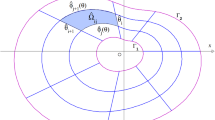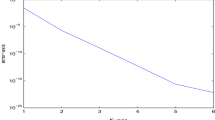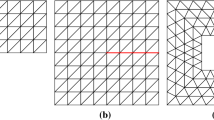Abstract
This is a mathematical study of the fundamental solutions method (or the charge simulation method) for a two-dimensional Dirichlet problem: Δu = 0 inΩ,u| ∂Ω =f for an annular domainΩ = {x ∈R 2 | ρ1 < ∥x∥ < ρ2}, where the boundary dataf is assumed to have exponentially decaying Fourier coefficients. Emphasis is laid on the comparison of the conventional scheme and the “invariant” scheme; the former adopts\(u^{(N)} (x) = - \frac{1}{{2\pi }}\sum\nolimits_{j = 1}^N {Q_j \log \left\| {x - y_j } \right\|} \) (where y j ∈R 2-Ω (j=1, …,N) are charge points) and the latter uses\(u^{(N)} (x) = Q_0 - \frac{1}{{2\pi }}\sum\nolimits_{j = 1}^N {Q_j \log \left\| {x - y_j } \right\|} \) with coefficientsQ j (j=0,1, …,N) subject to\(\sum\nolimits_{j = 1}^N {Q_j = 0} \) (the “invariant” scheme, proposed recently by the author, remains invariant with respect to trivial affine transformations in the problem description). When the charge points are distributed with natural symmetry on the circles ‖y‖=R 1,R 2 (whereR 1 <ρ 1 <ρ 2 < R2) and the collocation points are on the circles ‖x‖ =ρ 1,ρ 2, it is found that the conventional scheme converges exponentially to the true solution with the increase ofN providedR 2 ≠ 1, whereas exponential convergence is always the case with the “invariant” scheme (irrespective ofR 2) The results show that the “invariant” scheme is not only physically but also mathematically nicer than the conventional scheme.
Similar content being viewed by others
References
K. Amano, Error properties of numerical conformal mapping based on the charge simulation method (in Japanese). Trans. Information Processing Soc. Japan,32 (1991), 1–10.
A. Bogomolny, Fundamental solutions method for elliptic boundary value problems. SIAM J. Numer. Anal.,22 (1985), 644–669.
G. Fairweather and R.L. Johnston, The method of fundamental solutions for problems in potential theory. Treatment of Integral Equations by Numerical Methods (eds. C.T. Baker and G.F. Miller), Academic Press, New York, 1982, 349–359.
G. Hsiao and R.C. MacCamy, Solution of boundary value problems by integral equations of the first kind. SIAM Review,15 (1973), 687–705.
M. Katsurada, A mathematical study of the charge simulation method II. J. Fac. Sci., Univ. Tokyo, Sec. IA, Math.,36 (1989), 135–162.
M. Katsurada, Asymptotic error analysis of the charge simulation method in a Jordan region with an analytic boundary. J. Fac. Sci., Univ. Tokyo, Sec. IA, Math.37 (1990), 635–657.
M. Katsurada and H. Okamoto, A mathematical study of the charge simulation method I. J. Fac. Sci., Univ. Tokyo, Sec. IA. Math.,35 (1988), 507–518.
T. Kitagawa, On the numerical stability of the method of fundamental solution applied to the Dirichlet problem. Japan J. Appl. Math.,5 (1988), 123–133.
R. Mathon and R.L. Johnston, The approximate solution of elliptic boundary value problems by fundamental solutions. SIAM J. Numer. Anal.,14 (1977), 638–650.
S. Murashima, Charge Simulation Method and Its Applications (in Japanese), Morikita-Shuppan, Tokyo, 1983.
K. Murota, On “invariance” of schemes in the fundamental solution method (in Japanese). Trans. Information Processing Soc. Japan,3 (1993), 533–535.
H. Okamoto and M. Katsurada, A rapid solver for the potential problems (in Japanese). Bull. Japan Soc. Indust. Appl. Math.,2 (1992), 212–230.
M. Shōji, An application of the charge simulation method to a free boundary problem. J. Fac. Sci., Univ. Tokyo. Sec. IA, Math.,33 (1986), 523–539.
H. Singer, H. Steinbigler and P. Weiss, A charge simulation method for the calculation of high voltage fields, IEEE Trans. Power Apparatus Systems, PAS-93 (1974), 1660–1668.
M. Sugihara, On approximations of harmonic functions (in Japanese). Kokyuroku, Res. Inst. Math. Sci., Kyoto Univ.,678 (1988), 251–261.
Author information
Authors and Affiliations
About this article
Cite this article
Murota, K. Comparison of conventional and “invariant” schemes of fundamental solutions method for annular domains. Japan J. Indust. Appl. Math. 12, 61–85 (1995). https://doi.org/10.1007/BF03167382
Received:
Issue Date:
DOI: https://doi.org/10.1007/BF03167382




